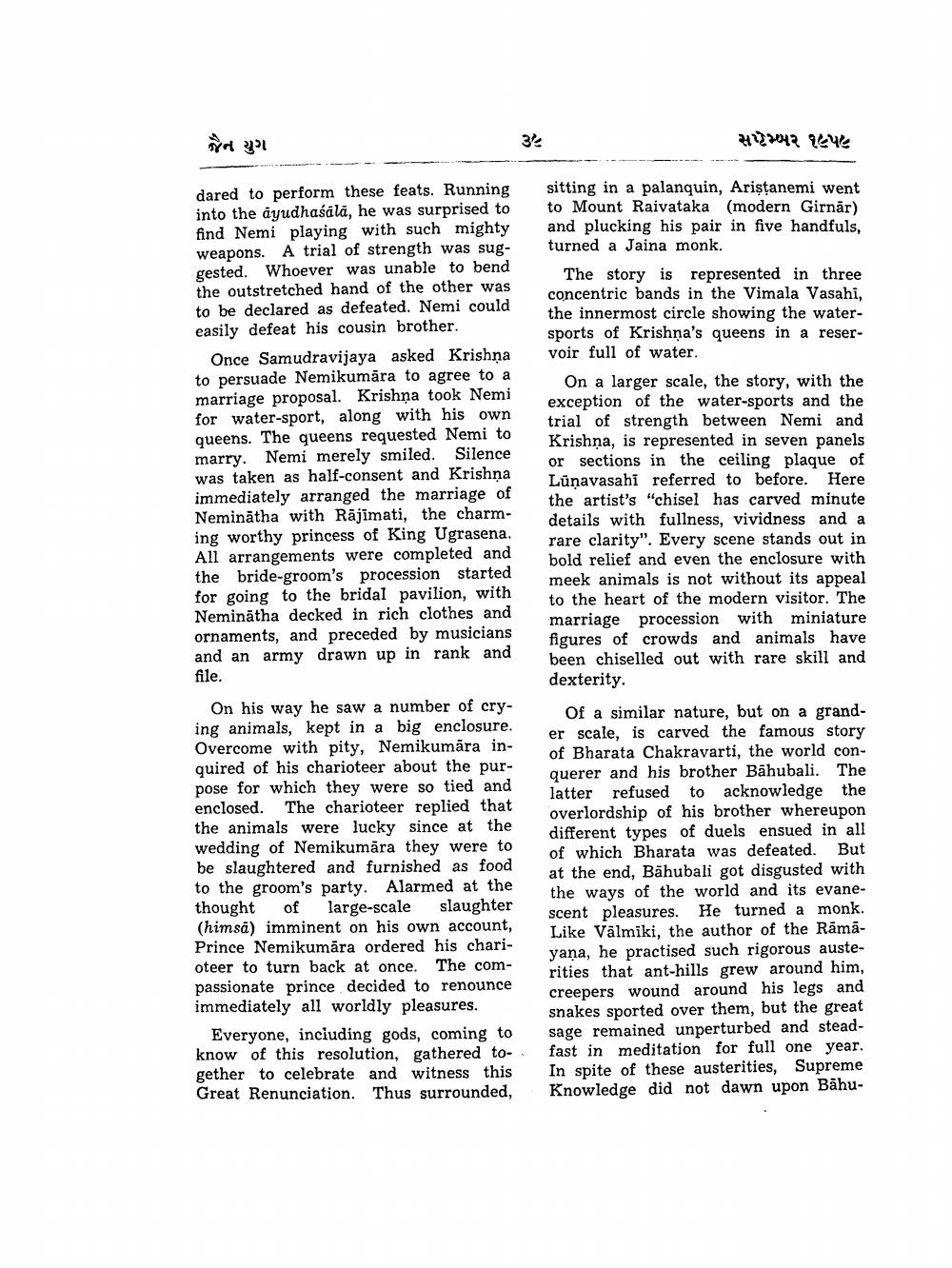________________
જેન યુગ
32
સપ્ટેમ્બર ૧૯૫૦
dared to perform these feats. Running into the ayudhasála, he was surprised to find Nemi playing with such mighty weapons. A trial of strength was suggested. Whoever was unable to bend the outstretched hand of the other was to be declared as defeated. Nemi could easily defeat his cousin brother.
Once Samudravijaya asked Krishna to persuade Nemikumāra to agree to a marriage proposal. Krishna took Nemi for water-sport, along with his own queens. The queens requested Nemi to marry. Nemi merely smiled. Silence was taken as half-consent and Krishna immediately arranged the marriage of Neminātha with Rājimati, the charming worthy princess of King Ugrasena. All arrangements were completed and the bride-groom's procession started for going to the bridal pavilion, with Neminātha decked in rich clothes and ornaments, and preceded by musicians and an army drawn up in rank and file.
sitting in a palanquin, Aristanemi went to Mount Raivataka (modern Girnar) and plucking his pair in five handfuls, turned a Jaina monk.
The story is represented in three concentric bands in the Vimala Vasahi, the innermost circle showing the watersports of Krishna's queens in a reservoir full of water.
On a larger scale, the story, with the exception of the water-sports and the trial of strength between Nemi and Krishna, is represented in seven panels or sections in the ceiling plaque of Lūņavasahi referred to before. Here the artist's "chisel has carved minute details with fullness, vividness and a rare clarity". Every scene stands out in bold relief and even the enclosure with meek animals is not without its appeal to the heart of the modern visitor. The marriage procession with miniature figures of crowds and animals have been chiselled out with rare skill and dexterity.
On his way he saw a number of crying animals, kept in a big enclosure. Overcome with pity, Nemikumāra inquired of his charioteer about the purpose for which they were so tied and enclosed. The charioteer replied that the animals were lucky since at the wedding of Nemikumāra they were to be slaughtered and furnished as food to the groom's party. Alarmed at the thought of large-scale slaughter (himsa) imminent on his own account, Prince Nemikumāra ordered his charioteer to turn back at once. The compassionate prince decided to renounce immediately all worldly pleasures.
Everyone, including gods, coming to know of this resolution, gathered together to celebrate and witness this Great Renunciation. Thus surrounded,
Of a similar nature, but on a grander scale, is carved the famous story of Bharata Chakravarti, the world conquerer and his brother Bahubali. The latter refused to acknowledge the overlordship of his brother whereupon different types of duels ensued in all of which Bharata was defeated. But at the end, Bahubali got disgusted with the ways of the world and its evanescent pleasures. He turned a monk. Like Valmiki, the author of the Rāmāyana, he practised such rigorous austerities that ant-hills grew around him, creepers wound around his legs and snakes sported over them, but the great sage remained unperturbed and steadfast in meditation for full one year. In spite of these austerities, Supreme Knowledge did not dawn upon Bāhu




